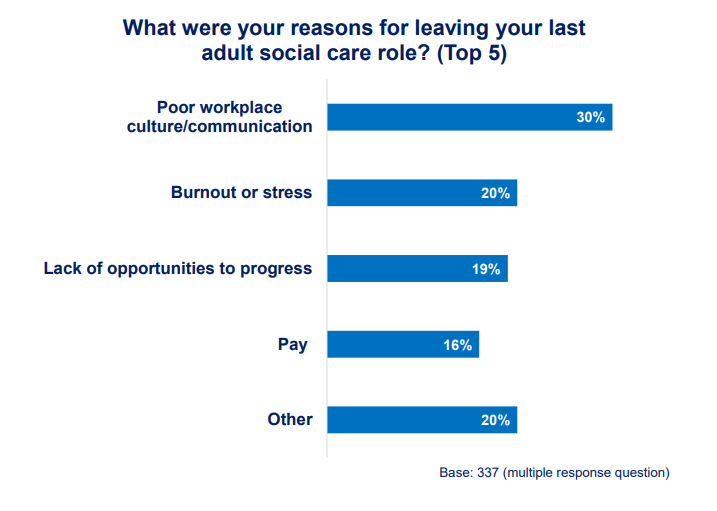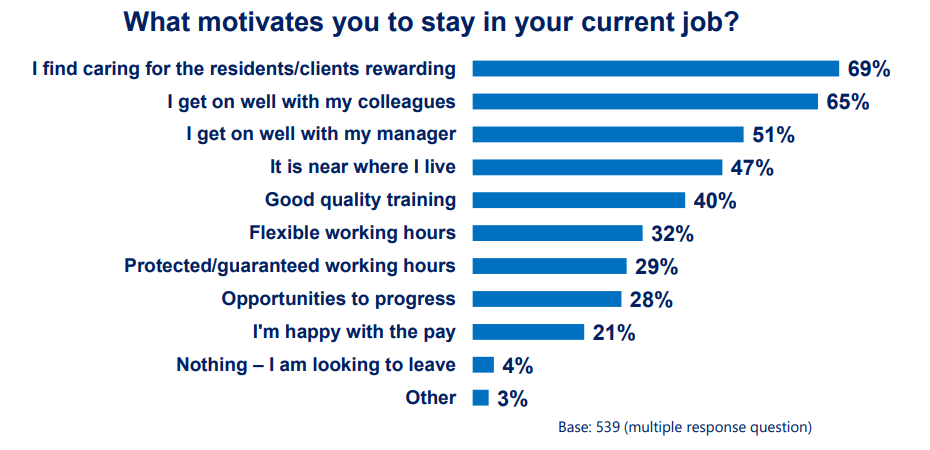High care worker turnover in domiciliary care continues to be one of a care manager’s biggest headaches. The latest data from Skills for Care's workforce intelligence tracker, reveals the staff turnover rate in domiciliary care was 24.1% in 2024/25 - a slight improvement on last year’s 25.3%.

For care workers specifically on the frontline of homecare though, the turnover rate is often higher. The current turnover rate for care workers is 29.7%. So what can we do about it?
Jump to:
What causes high staff turnover in homecare?
Firstly, it’s important to understand the reasons underlying the high staff turnover in homecare. According to Skills for Care’s workforce data (2025), there are a multitude of factors which affect turnover with the care workforce. Among some of the most significant are:
-
Age - the turnover rate is highest amongst care staff aged under 25 (38%). Staff turnover decreases as age increases.
-
Tenure - turnover is much higher within the first year of a caring role (34%)
-
Experience - turnover rate decreases the longer someone works in care (it's 17% when working in care for more than a decade)
-
Pay - care workers being paid more than 50% below the local authority average have a turnover rate of 28%
-
Conditions - turnover rate is highest for care workers on zero hour contracts (31%)
-
Training - turnover is 25% for care workers receiving some form of training in the last year, compared to 30% for those who had not
-
Distance - the turnover rate increases with distance from work (for example, turnover is 25% if a care worker travels 15km or more from home to a visit, compared with 21% if travelling less than 1km)
Skills for Care also identified a multiplier effect, indicating that care workers who enjoyed several positive employment factors (such as pay, training, contracts and conditions) were much more likely to stay in their jobs, than care workers who didn’t have them.
Why do care workers leave their jobs?
So what makes care workers actually leave their jobs in domiciliary care? In a research report from 2023, Skills for Care uncovered the main reasons for adult social care workers leaving their last role. The top reason was poor workplace culture and/or communication (30%), followed by burnout or stress (20%), lack of opportunities to progress (19%) and then pay (16%).
 Source: Skills for Care (2023)
Source: Skills for Care (2023)
In addition, Nursebuddy found in a survey of domiciliary care workers that long hours combined with low pay was the single biggest reason for quitting. A particular issue here was overly long, frequent intervals of unpaid waiting time during the day, which left carers sitting in their cars with time on their hands, but not enough of a gap to be able to go home or do something valuable with their spare time.
Why do care workers stay in their jobs?
The same research from Skills for Care also revealed the reasons why some care workers stay in their jobs. Interestingly, the most common reason for staying in care directly relates to many care workers’ motivations to work in care in the first place.
 Source: Skills for Care (2023)
Source: Skills for Care (2023)
Aside from the rewarding nature of care, culture, working conditions and opportunities for development and progression were all rated as important reasons why care workers choose to stay in their current roles.
What are care organisations with a low staff turnover doing right?
There are also lessons to be learned from successful care providers. A ‘Secrets of success’ report compiled by Skills for Care in 2017 spoke to care organisations with a staff turnover of less than 10% to find out what they were doing right. The report uncovered the following factors as having a significant impact on staff turnover:
-
Investing in learning and development
-
Embedding the values of your organisation
-
Celebrating achievements - of the business and of individual care workers
-
Involving all colleagues in decision making
-
Paying staff above the minimum local rates
-
Giving staff additional responsibilities
-
Using CQC reports as a catalyst for improvement
-
Reviewing workplace culture
From talking to our own homecare customers, Nursebuddy has discovered similar trends amongst organisations who are doing well at retaining their care teams.
One great example is Caroline Cares for You, a twice-rated Outstanding homecare provider based in Brackley, Northamptonshire. The company’s staff retention rate is close to 100% and some of the reasons for that, include:
Salaried staff - carers receive a salary rather than pay per visit, which gives their care team stability
Training opportunities - the time when staff are not at visits is used to catch-up on training and personal development
Progression opportunities - every member of staff has an annual performance review, but recognising that not everyone wants to keep moving up into more senior roles, the business has created ‘champions’ for things like activities or events, as a way of continually promoting and rewarding their team
Office chats - all carers have regular 1-2-1 time with their managers to talk about anything they want
Listening & learning - the leadership team at Caroline Cares for You are regularly starting new initiatives based on feedback from their team, such as planting a tree each quarter to offset their carbon footprint, as many members of the team (and their children!) were concerned about the impact of disposable PPE
Going digital - having care software systems in place like Nursebuddy is helping Caroline Cares for You become a more sustainable, paper-free office, and their carers love the fact that they don’t have loads of paperwork to fill in.
Find out more: 6 ways Nursebuddy is helping to reduce carer turnover in homecare
What can be done to improve care worker retention?
Looking back over the reasons why care workers leave and stay in their jobs, as well as learning from the practical examples of successful homecare agencies, a few core themes emerge for how to reduce care worker turnover and improve staff retention.
Pay and conditions - stability matters to a homecare workforce. Whether that’s sharing the visit schedule in advance, placing the care team on salaried contracts, paying above minimum wage brackets or actively reducing unpaid waiting time, providing your care team with stability and security will help to retain them in the long-term.
Learning and development - make time for your care team to work on their professional development. Offer training in new types of care skills or formalise their experience with something like the Care Certificate or an apprenticeship. Helping your team to grow in their caring roles will mean they are more likely to stay.
Opportunities for progression - find ways to give your team new responsibilities where they want them, whether that’s promotion upwards into a more senior role, or an additional ‘champion’ role where they have the opportunity to make something meaningful of their own.
Involving your team - make time to listen to your team members and involve them in the decisions your business is making. That could be through setting up face-to-face chats with your team, or you could use a survey to gain an insight into the team’s general mood.
The right tools - give care workers access to resources that make it easy to do their job and don't create unnecessary friction. An app for care workers can be a way to improve communication, as well as reducing stress, by equipping care workers with the information and tools they need to do their job well.
 Jayne Scarman is Head of Marketing at Nursebuddy, a Finland-based homecare management platform and app. A purpose-led content marketer and writer, Jayne has spent the last five years in homecare software, a place which definitely feels like home to her. With a varied background across health, care and education, in multiple continents, she helps organisations like Nursebuddy reach the right audiences through a singular focus on their “why”.
Jayne Scarman is Head of Marketing at Nursebuddy, a Finland-based homecare management platform and app. A purpose-led content marketer and writer, Jayne has spent the last five years in homecare software, a place which definitely feels like home to her. With a varied background across health, care and education, in multiple continents, she helps organisations like Nursebuddy reach the right audiences through a singular focus on their “why”.
.jpg?width=1600&height=1000&name=Featured%20-%20care%20worker%20turnover%20(1).jpg)





